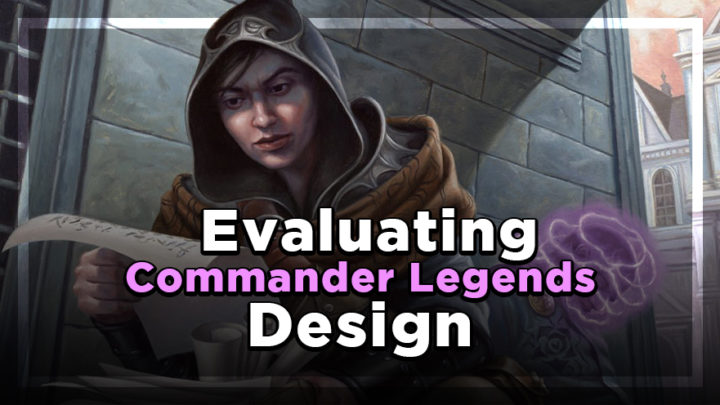Nine years ago, Commander (2011) broke new ground by introducing new cards in a Magic deck product. With the release of Commander Legends, we’re seeing a similarly large milestone.
Designing Commander Legends is a unique puzzle to solve. It inherits Commander’s problem of naturally-slow games, and the drafting portion of Limited is tough to combine with Commander’s color identity restrictions. So, how does Commander Legends make Commander draft work?
In designing Commander Legends to solve these problems, Wizards also created cards that have a unique impact outside of the set – from rounding out land cycles in Commander to making a splash in Pauper and Legacy.
Ready, partner? Let’s cascade.
Monarch
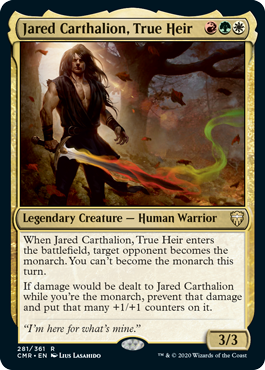
Jared Carthalion, True Heir exemplifies an important design element for multiplayer draft: incentive for attacking. Board stalls are common in Commander because it’s so risky to attack other players without a clear reward. Adding monarch to the game encourages players to swing sideways. More importantly, Jared goes a step further than other monarch cards. You’re not only incentivized to attack the monarch—you have extra rewards for becoming the monarch yourself.
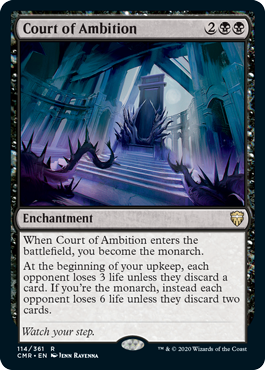
Besides Jared, monarch cards appear for all colors in Commander Legends and at multiple rarities. This volume ensures that most games of Commander Legends limited will include this element of gameplay. The rare Court cycle smartly rewards you even when you lose monarch, keeping the cards playable and making it more likely that players will include them in draft decks. Court of Ambition dispenses a harsh ultimatum when you’re the monarch, which makes opponents fight for the crown. This results in games that end more quickly and adds more meaningful choices for whom to attack.
Encore & Cascade
Two elements of the casual Commander experience are large, splashy spells and high variance in game outcomes. While this is easier to achieve in Constructed, Commander Legends utilizes a couple mechanics to simulate this in Limited. Encore enables you to go big, and cascade amps up the randomness.
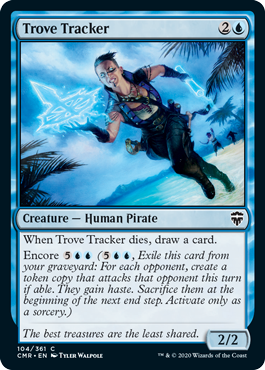
The encore mechanic on several cards, including commons, helps ensure Commander Legends games won’t slow to a crawl. For example, Trove Tracker is a great blocker in the early game and a Concentrate later on. Other encore cards like Phyrexian Triniform, which creates nine 3/3 Golems, help simulate the “big effects” that have become hallmarks of the Commander experience.
The sorcery speed of encore empowers the active player to make aggressive plays. If encore were instant-speed, it would discourage attacking and have detrimental effects on both Commander Legends Limited and Commander. Encore creates a healthy ebb and flow of “tides of war.” Coastline Marauders tokens deal eighteen trample damage, and you can follow them up the following turn with another player’s encored pirate.
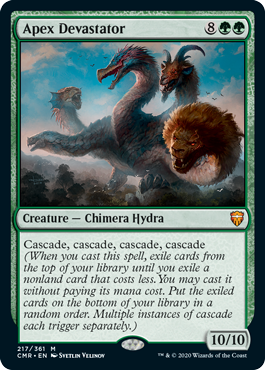
To fully capture the Commander experience in Limited, Commander Legends needed to simulate the wildly varying ways Commander games can unfold. Commander’s card pool spans the entirety of Magic’s history, but Commander Legends has a much more limited card pool. To solve this problem, Wizards turned to the cascade mechanic from Alara block. Cascade helps deliver the “unexpected results” experience all on one card, which only increases Commander Legends’ economy.
Apex Devastator extends what encore provides for the “big, splashy spell” factor. The possibility of cascading into a game-ending result with four random cards feels close to a Warp World effect. Even cascading into four mana rocks makes for memorable, hilarious gameplay you’ll only find in Commander.
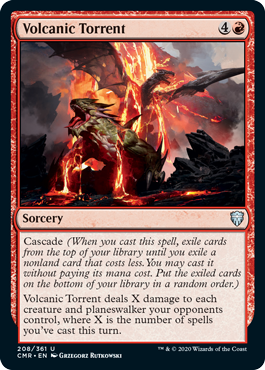
However, Apex Devastator costs a whopping ten mana, and players may end up cutting high converted mana cost cascade spells from their draft deck, fearing they won’t survive long enough to cast them. Thankfully, there are cards with lower CMC’s – like Volcanic Torrent and Averna, the Chaos Bloom – to help players find value in playing cascade. Sakashima’s Protege and Aurora Phoenix also become valuable as you include more cascade in your deck.
Partner
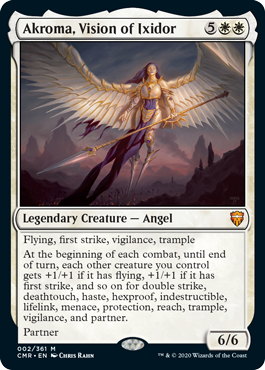
The biggest problem with designing “Commander Limited” is figuring out how to handle color identity. If the set had too many monocolored cards, it would be hard to find a commander with a color identity matching your deck; with too many multicolored cards, you’d end up with too few playable picks. And if Wizards chose to remove the color identity restriction altogether, too many players would be incentivized to draft “five-color good stuff” decks, thus removing a key strategic element of draft.
Thankfully, Wizards found a solution to this problem by adding another multiplayer-focused mechanic to Commander Legends: partner. With partner, you can draft Akroma, Vision of Ixidor knowing you’ll likely have a white deck. Perhaps, in the beginning, you drafted a green commander, only to find Profane Transfusion, a black card. You want to play it, so you switch to white-black. Luckily, it’s easy to find one of six black partner commanders. You find Falthis, Shadowcat Familiar later in the draft, which synergizes with Akroma’s “keywords matter” ability. If a neighboring drafter is drafting white cards, you can easily switch into black-green.
In short, partner gives players to flexibility to stay open as they draft Commander Legends, and the new partners in the set give Commander players even more deck-building options.
Impact on Constructed Formats
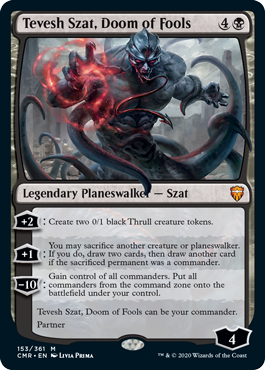
Designing for Commander Legends prioritizes making the product work first. However, these same cards can also impact formats like Pauper, Legacy, and of course, Commander!
Partner is just one example of how solving a problem for Limited can be a net positive for Constructed. When partner was first introduced in 2016, it was printed on a limited number of two-color cards. With so few partner commanders to choose from, you were likely to repeat the same two-partner combination another player used. Now, with new, monocolored partners, players that want to build a partner deck have thousands of deck-building options.
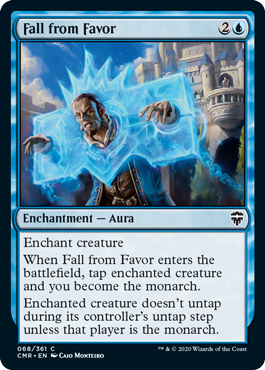
Monarch has already made an impact in Legacy with the printing of Palace Jailer in Conspiracy: Take the Crown. It looks like Fall from Favor may do the same for Pauper. Monarch is easy to foil in Commander Legends, but it’s tougher to do in 1v1 play, especially when the card granting monarch is a piece of creature removal. This gives the non-monarch player an even greater disadvantage as they try to stop the monarch’s card draw.
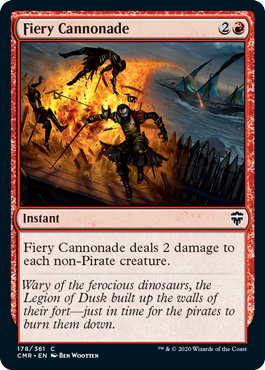
Commander Legends also downshifted board sweepers to enable its Commander Limited environment. Fiery Cannonade, which was downshifted from uncommon to common, will now become Pauper-legal for the first time. Due to the constraints of Standard premier sets, it’s hard to come by red sweepers. Reprinting Fiery Cannonade helps even the playing field for red Pauper decks.
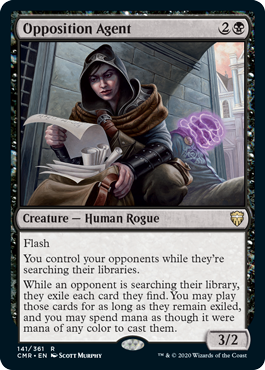
Opposition Agent has already generated a lot of discussion based on its uses in Commander. However, the ability to affect searching libraries is also relevant to Legacy. There’s a lot more need for fetching and tutoring cards in Legacy, so Opposition Agent has the potential to make an impact.
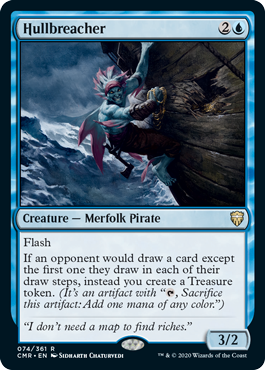
Similarly, Hullbreacher is relevant in both Commander and Legacy. Drawing more than one card in a turn is not uncommon in Legacy, where cards like Brainstorm and Ponder see regular play. Will it be enough to breach the format?
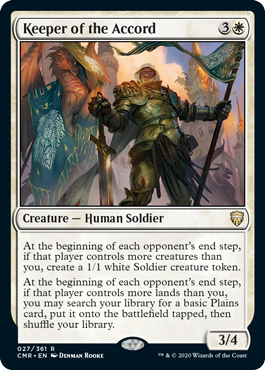
Keeper of the Accord and the enemy color pair “crowd lands” like Training Center are also essential additions to Commander.
The five new lands round out the incomplete cycle introduced in Battlebond. Now, a Mardu deck can include the new Vault of Champions and Spectator Seating, which puts them on the same footing as, say, Esper decks.
Meanwhile, Keeper of the Accord adds more support to white’s slice of the color pie for Commander. When everyone starts at 40 life, ramp and card advantage are essential to all players, regardless of what colors they choose to play. As mono-white decks look for ramping options, Keeper of the Accord is now a new staple, and I look forward to seeing more cards like it in future sets.
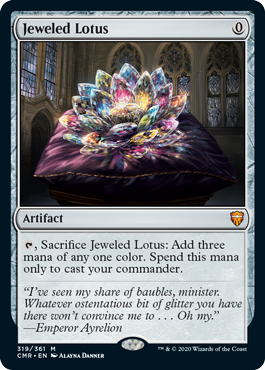
Finally, let’s address the lotus in the room. I believe Jeweled Lotus is a design mistake, and not because it’s necessarily too powerful to answer. In fact, for many decks, I’d say Jeweled Lotus is an “auto-include.” That’s the problem.
Let’s examine Arcane Signet. It’s a strictly better mana rock than Fellwar Stone and the Ravnican Signets. In most decks with colors, it’s too strategic to avoid including Arcane Signet. Your deck-building choices are diminished by one card slot.
This is the same issue with Jeweled Lotus, only on a different axis than color identity. Some decks don’t benefit from casting their commanders so early. But for decks that would gain a substantive boon, it’s hard to justify not including Jeweled Lotus. When designing for Commander, it’s important to avoid removing a deck-building decision point for many decks.
Gavin Verhey tweeted admitting Arcane Signet was a mistake. I’d say Jeweled Lotus doesn’t fall far from the Arcane Signet tree.
End the Turn
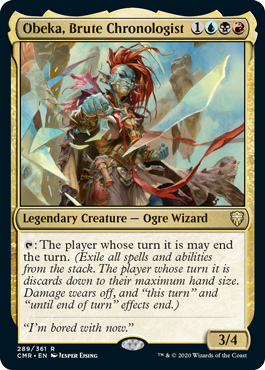
Commander Legends’ unique design solutions have created a fun and challenging draft experience, and they’ll have an indelible impact on Magic as a whole. There are now an astronomical amount of partner combinations, souped-up commons shaking up Pauper, and new cards for Legacy players to consider.
Thanks for reading! Have any thoughts to share on Commander Legends or Magic design? Tweet me at @bradleyrose.
See you next — oh wait, forgot to draw a card off the monarch trigger.
Okay, we’re good. See you next time!

Bradley is a co-host of a weekly Magic: The Gathering design podcast, Beacon of Creation. He was among the Top 101 contestants in Wizards of the Coast’s Great Designer Search 2. He enjoys crafting custom Magic product experiences, like Archfrenemies, and building Commander decks with creative constraints.

